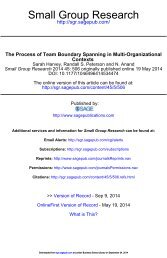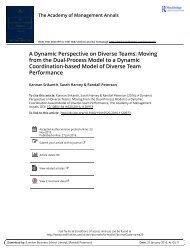Group Dynamics in Top Management Teams: Groupthink, Vigilance, and Alternative Models of Organizational Failure and Success
This study explored the heuristic value of Janis’ (1982) groupthink and vigilant decision making models as explanations of failure and success in top management team decision making using the Organizational Group Dynamics Q-sort (GDQ). Top management teams of seven Fortune 500 companies were examined at two historical junctures—one when the team was successful (defined as satisfying strategic constituencies) and one when the team was unsuccessful. Results strongly supported the notion that a group’s decision making process is systematically related to the outcomes experienced by the team. Ideal-type Q-sorts organized around Janis’ analysis of groupthink and vigilance were substantially correlated with Q-sorts of failing and successful groups, respectively. The fit was, however, far from perfect. Ideal type Q-sorts derived from other frameworks correlated better with the failure–success classification than did the Janis-derived ideal types. Successful groups showed some indicators of groupthink (e.g., risk-taking, cohesion, and strong, opinionated leaders), whereas unsuccessful groups showed signs of vigilance (e.g., internal debate to the point of factionalism). The results illustrate the usefulness of the GDQ for developing and empirically testing theory in organizational behavior from historical cases.
This study explored the heuristic value of Janis’ (1982) groupthink
and vigilant decision making models as explanations of
failure and success in top management team decision making
using the Organizational Group Dynamics Q-sort (GDQ). Top
management teams of seven Fortune 500 companies were examined
at two historical junctures—one when the team was successful
(defined as satisfying strategic constituencies) and one when the team was unsuccessful. Results strongly supported the notion
that a group’s decision making process is systematically related
to the outcomes experienced by the team. Ideal-type Q-sorts organized
around Janis’ analysis of groupthink and vigilance were
substantially correlated with Q-sorts of failing and successful
groups, respectively. The fit was, however, far from perfect. Ideal type
Q-sorts derived from other frameworks correlated better
with the failure–success classification than did the Janis-derived
ideal types. Successful groups showed some indicators of groupthink
(e.g., risk-taking, cohesion, and strong, opinionated leaders),
whereas unsuccessful groups showed signs of vigilance (e.g.,
internal debate to the point of factionalism). The results illustrate
the usefulness of the GDQ for developing and empirically testing
theory in organizational behavior from historical cases.
- No tags were found...
Create successful ePaper yourself
Turn your PDF publications into a flip-book with our unique Google optimized e-Paper software.
294 PETERSON ET AL.<br />
APPENDIX A—Cont<strong>in</strong>ued<br />
<strong>Group</strong> Time Leader/CEO Texts<br />
S 1988 Henry Kravis Burrough, B.,& Helyar, J. (1990). Barbarians<br />
at the gate. New York:<br />
Harper & Row<br />
Lampert, H. (1990). True Greed. New<br />
York: New American Library.<br />
Xerox<br />
U 1977–1979 C. Peter Jacobson, G., & Hillkirk, J. (1986).<br />
McColough<br />
Xerox: American samurai. New<br />
York: Macmillan.<br />
Kearns, D. T., & Nadler, D. A. (1992).<br />
Prophets <strong>in</strong> the dark: How Xerox re<strong>in</strong>vented<br />
itself <strong>and</strong> beat back the Japanese.<br />
New York: HarperColl<strong>in</strong>s.<br />
S 1985–1986 David Kearns Jacobson, G., & Hillkirk, J. (1986).<br />
Xerox: American samurai. New<br />
York: Macmillan.<br />
Kearns, D. T., & Nadler, D. A. (1992).<br />
Prophets <strong>in</strong> the dark: How Xerox re<strong>in</strong>vented<br />
itself <strong>and</strong> beath back the<br />
Japanese. New York: HarperColl<strong>in</strong>s.<br />
Note. U, unsuccessful groups; S, successful groups.<br />
APPENDIX B<br />
<strong>Organizational</strong> <strong>Group</strong> <strong>Dynamics</strong> Q-Sort: Process Indicator Scales<br />
Intellectual Rigidity–Flexibility<br />
19. The group refuses to ab<strong>and</strong>on fail<strong>in</strong>g or unsound policies <strong>in</strong> response to serious setbacks<br />
(i.e., an aversion to serious self-criticism).<br />
vs<br />
***The group adjusts fail<strong>in</strong>g policies <strong>in</strong> a timely fashion (i.e., the group recognizes shortcom<strong>in</strong>gs<br />
<strong>and</strong> attempts to cut its losses by mak<strong>in</strong>g midcourse changes).<br />
37. There is a great deal <strong>of</strong> xenophobia or suspiciousness toward outsiders with<strong>in</strong> the group.<br />
vs<br />
***The group is open to a wide range <strong>of</strong> cultural <strong>and</strong> <strong>in</strong>tellectual <strong>in</strong>fluences.<br />
40. Dissent is not acceptable even with<strong>in</strong> private group meet<strong>in</strong>gs; the group ostracizes dissenters<br />
<strong>and</strong> punishes them severely.<br />
vs<br />
***Private criticism with<strong>in</strong> group meet<strong>in</strong>gs is not only acceptable, it is actively encouraged<br />
as a way <strong>of</strong> improv<strong>in</strong>g decision mak<strong>in</strong>g.<br />
58. ***<strong>Group</strong> members are highly attuned to their environment <strong>and</strong> major changes occurr<strong>in</strong>g<br />
around them.<br />
vs<br />
Members are extremely slow to recognize the major changes occurr<strong>in</strong>g around them.<br />
***Direction <strong>of</strong> Q-sort item that measures the extreme end <strong>of</strong> the right-h<strong>and</strong> side <strong>of</strong> the scale.

















